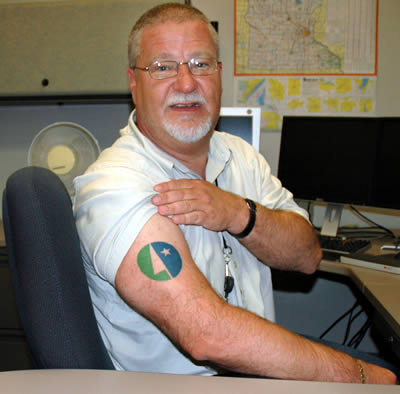By Bob Filipczak
Ken Gilman’s career, in many ways, mirrors the relationship between state troopers and FIRST drivers (Highway Helpers) as they work together to keep the Twin Cities freeways clear.

Ken Gilman flexes his Mn/DOT muscle and flashes his new tattoo. Photo by Bob Filipczak |
“When it works together like it’s supposed to, it really is a nice even flow,” he said.
Gilman, now a transportation program specialist 2 at the Regional Transportation Management Center in Roseville, moved to Mn/DOT after 25 years with the Department of Public Safety dispatching state troopers. He and his colleagues at RTMC Traffic Operations dispatch FIRST trucks throughout the Twin Cities as they roam the freeway system seeking out stalled vehicles, crashes—you name it. RTMC uses nearly 500 traffic management cameras in order to locate and verify incidents that occur on the freeway.
The move was, physically, only about 100 feet across the floor at the RTMC, but working for Mn/DOT has been a great step for Gilman. The schedule, the organization and the work itself—managing traffic and providing real-time traveler information—have all combined to reduce his stress and allow him more time with his family, particularly on the weekends.
He is so enthusiastic about his new job that, after passing his 90-day probationary period, he fulfilled his promise to get the Mn/DOT logo tattooed to his arm.
“Ken really has been a breath of fresh air for the Operations Center,” said TK Kramascz, the former RTMC operations supervisor who hired Gilman. “His enthusiasm is contagious and his incident management knowledge is second to none.”
Because Gilman brings a wealth of public safety experience with him, he understands the implications of motorists who find themselves stuck on the freeways. By getting the FIRST trucks to these vehicles, it reduces the chances of larger incidents (secondary crashes, for example) and improves traffic flow, Gilman said.
“And besides, and it’s one less thing the troopers have to worry about,” he said.
What does an average day look like to you?
I get here about 4:30 a.m. You log onto all the systems, you put the monitors up, and you turn everything on. The first thing you do in the morning is check changeable message signs and make sure they are all posting appropriate messages. You deal with the morning rush hour, and send FIRST drivers out to requests and anything we hear about on the State Patrol radio. We also monitor maintenance and road construction details throughout the day. If there are lane closures and patching, we follow up with the appropriate signs for the public and make sure the information makes it to 511 and the RTMC Web site.
What’s a bad day look like to you?
A bad day can start with a quarter inch of snow. It doesn’t take much snow to put people off the road. It can be pretty hectic. In a normal day we may have 10 pending events in the system we are monitoring to see if they clear. I’ve seen as many as 290 pending events during a snow event day.
What’s a good day look like?
A good day is a day like today (June 2, 2009). Traffic is moving, everything is going good, we are keeping up with all the construction details, we are putting up the appropriate signs, it’s nice and sunny out, and it’s going to be 70 degrees out. You can’t beat that.
Watching monitors all day, do you go home and not want to look at the TV?
I don’t go home and watch TV at all. You’re looking at those monitors at all times. You put in eight hours and you don’t think you would be that tired because it’s not manual labor; it’s more of a mental thing because you’re watching the event and acting on its behalf from its inception to the end of it. That can sometimes take several hours, so you are going from camera to camera.
The first two weeks I worked here I knew something was going on because I walked out of here and I was just tired. And one of my kids said to me, “But Dad, you don’t do anything.” It’s true I’m not out lifting concrete in the heat or anything, but you’re constantly got stuff going through your head.
Do you meet with the FIRST drivers from time to time?
We meet with them at their semi-monthly meetings. Likewise, they are invited out here to the RTMC Ops Center. I’ve met most of them now. It’s a nice way to exchange information and tell them a little about me and where I came from. Most of them knew me anyway because I worked for so long for the State Patrol and they listened to me on that main channel.
Do you ever do ride-alongs?
Not yet, but one of my goals is to get out there and ride along and learn some of the areas. The Twin Cities freeway system is so vast. There are places out in Maple Grove that I’ve never been to but I’m dispatching for.” Everything looks different in-person versus looking through a camera at 50 feet in the air.
Do you or a co-worker have an interesting job to share with readers? Click here to send us your ideas, and we’ll contact you for more information.
Recent employee profiles:
| 


